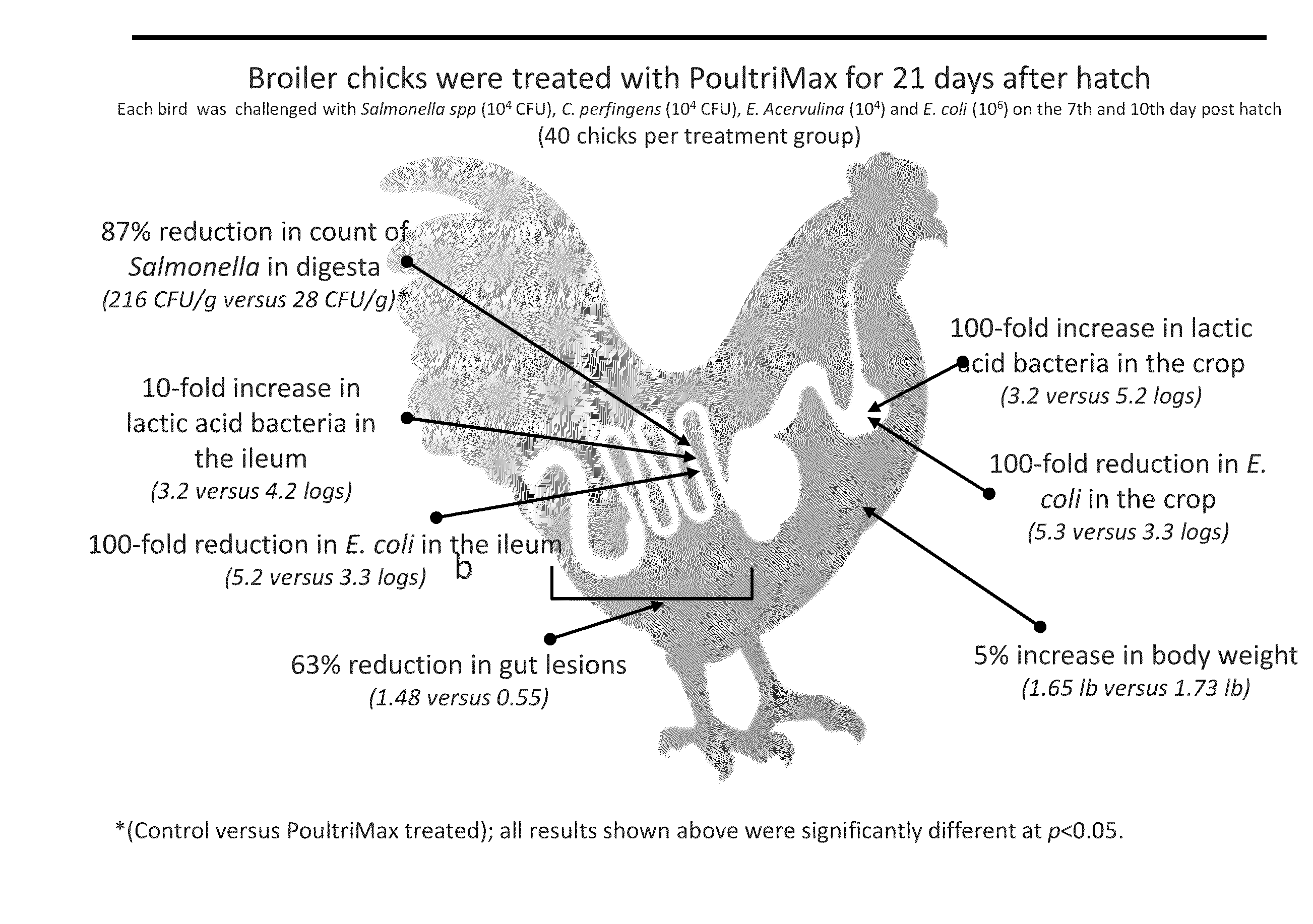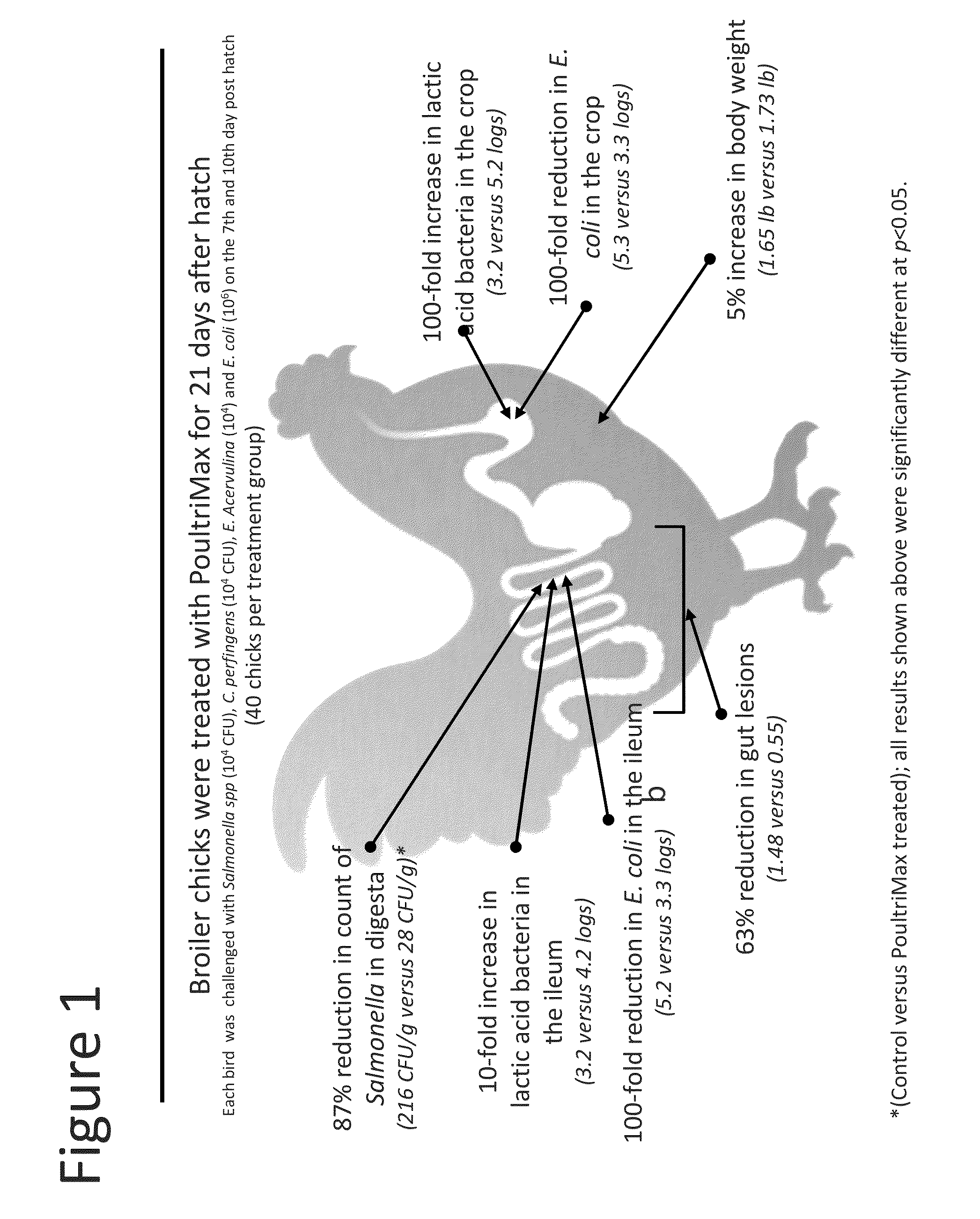Compositions and methods for reducing infection in poultry
a technology of compositions and methods, applied in the field of lactic acid bacteria, can solve the problems of reducing the resistance of birds raised on built-up litter to pathogen infection, and the work of ruminants may not work in poultry, so as to reduce the resistance of pathogen infection
- Summary
- Abstract
- Description
- Claims
- Application Information
AI Technical Summary
Benefits of technology
Problems solved by technology
Method used
Image
Examples
example 1
LAB Supplement Improves Feed Efficiency and Intestinal Lesions Under Mild Challenge Conditions in Chickens
[0044]This example describes the effect of LAB on feed efficiency and vaccination against coccidiosis when supplemented to newly hatched chickens as compared to vaccine, LAB plus vaccine and untreated controls. The LAB used in this Example is LA51 (aka NP51).
[0045]The test period began on the day of hatch of the chicks (Trial Day 0). The chicks were fed a commercial-type feed until the end of the study. On Trial Day 0 (or day of hatching), a total of 640 chicks were randomly assigned into 4 groups: (1) untreated control, (2) a commercially available vaccine against coccidiosis in chicken (“vaccine-C” in this Example), (3) LAB, (4) vaccine-C and LAB.
[0046]All birds designated to receive LAB in feed were sprayed with LAB at day of age (>5×107 cfu / bird). LAB was also added to the corn-soy based diet feed to achieve a dosage between 1 ×107 and 5×107 cfu per bird per day.
[0047]Built ...
example 2
LAB Supplement Improves Feed Efficiency and Intestinal Lesions Under Severe Challenge with Eimeria and E. coli in Chickens
[0052]This example describes the effect of LAB on feed efficiency and coccidiosis when supplemented to newly hatched chickens as compared to no-supplement controls. The LAB used in this Example is LA51 (aka NP51).
[0053]The test period began on the day of hatch of the chicks (Trial Day 0). The chicks were fed a commercial-type feed until the end of the study. On Trial Day 0 (or day of hatching), a total of 320 chicks were randomly assigned into 2 groups: (1) untreated control, and (2) LAB.
[0054]All birds designated to receive LAB in feed were sprayed with LAB at day of age (>5×107 cfu / bird). LAB was also added to the corn-soy based diet feed to achieve a dosage between 1 ×107 and 5×107 cfu per bird per day.
[0055]Built up litter bedding (with litter crust from previous trial) from at least three previous grow-outs was used to place minimum, but normal, “field condi...
example 3
LAB Supplement Improves Feed Efficiency and Intestinal Lesions Under Severe Challenge with Eimeria and Clostridium in Chickens
[0061]This example describes the effect of LAB on feed efficiency and coccidiosis when LAB were supplemented to newly hatched chickens as compared to no-supplement controls. The LAB used in this Example is LA51 (aka NP51).
[0062]The test period began on the day of hatch of the chicks (Trial Day 0). The chicks were fed a commercial-type feed until the end of the study. On Trial Day 0 (or day of hatching), a total of 320 chicks were randomly assigned into 2 groups: (1) untreated control, and (2) LAB.
[0063]All birds designated to receive LAB in feed were sprayed with LAB at day of age (>5×107 cfu / bird). LAB was also added to the corn-soy based diet feed to achieve a dosage between 1 ×107 and 5×107 cfu per bird per day.
[0064]Built up litter bedding (with litter crust from previous trial) from at least three previous grow-outs was used to place minimum, but normal,...
PUM
| Property | Measurement | Unit |
|---|---|---|
| weight | aaaaa | aaaaa |
| weight | aaaaa | aaaaa |
| weight | aaaaa | aaaaa |
Abstract
Description
Claims
Application Information
 Login to View More
Login to View More - R&D
- Intellectual Property
- Life Sciences
- Materials
- Tech Scout
- Unparalleled Data Quality
- Higher Quality Content
- 60% Fewer Hallucinations
Browse by: Latest US Patents, China's latest patents, Technical Efficacy Thesaurus, Application Domain, Technology Topic, Popular Technical Reports.
© 2025 PatSnap. All rights reserved.Legal|Privacy policy|Modern Slavery Act Transparency Statement|Sitemap|About US| Contact US: help@patsnap.com


